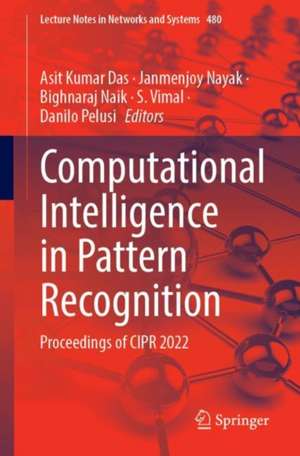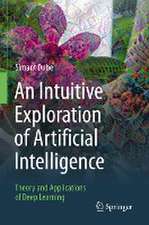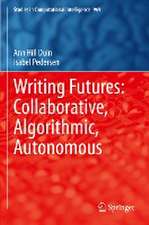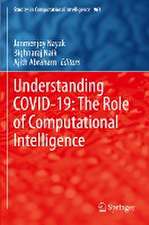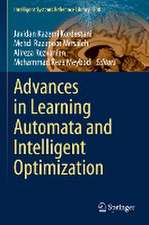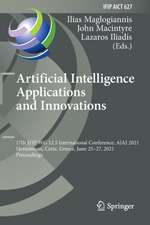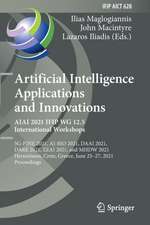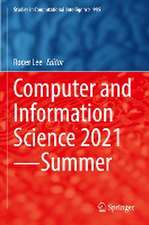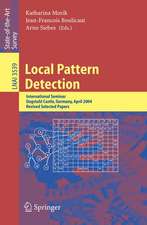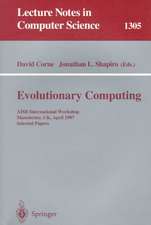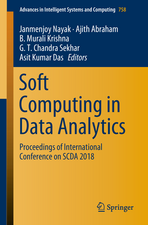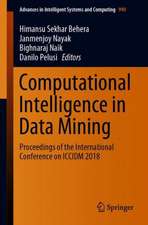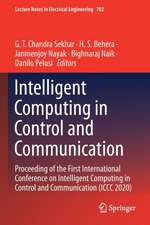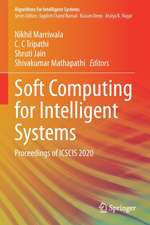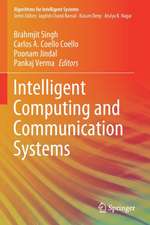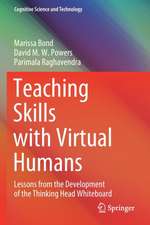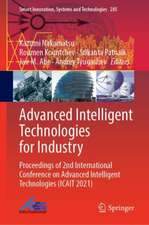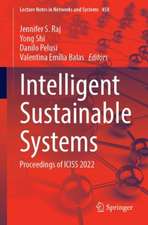Computational Intelligence in Pattern Recognition: Proceedings of CIPR 2022: Lecture Notes in Networks and Systems, cartea 480
Editat de Asit Kumar Das, Janmenjoy Nayak, Bighnaraj Naik, S. Vimal, Danilo Pelusien Limba Engleză Paperback – 22 iun 2022
| Toate formatele și edițiile | Preț | Express |
|---|---|---|
| Paperback (2) | 1462.00 lei 6-8 săpt. | |
| Springer Nature Singapore – 27 aug 2023 | 1473.39 lei 3-5 săpt. | |
| Springer Nature Singapore – 22 iun 2022 | 1462.00 lei 6-8 săpt. |
Din seria Lecture Notes in Networks and Systems
- 20%
 Preț: 1019.63 lei
Preț: 1019.63 lei - 20%
 Preț: 1286.10 lei
Preț: 1286.10 lei -
 Preț: 282.79 lei
Preț: 282.79 lei - 20%
 Preț: 1463.18 lei
Preț: 1463.18 lei - 18%
 Preț: 1105.88 lei
Preț: 1105.88 lei - 20%
 Preț: 1462.99 lei
Preț: 1462.99 lei - 20%
 Preț: 1459.86 lei
Preț: 1459.86 lei - 20%
 Preț: 1464.33 lei
Preț: 1464.33 lei - 18%
 Preț: 1398.62 lei
Preț: 1398.62 lei - 20%
 Preț: 1455.89 lei
Preț: 1455.89 lei - 18%
 Preț: 1214.72 lei
Preț: 1214.72 lei - 20%
 Preț: 999.35 lei
Preț: 999.35 lei - 20%
 Preț: 1348.81 lei
Preț: 1348.81 lei - 18%
 Preț: 966.27 lei
Preț: 966.27 lei - 20%
 Preț: 1690.34 lei
Preț: 1690.34 lei - 20%
 Preț: 1231.38 lei
Preț: 1231.38 lei - 20%
 Preț: 1317.46 lei
Preț: 1317.46 lei - 20%
 Preț: 1325.71 lei
Preț: 1325.71 lei - 20%
 Preț: 1833.90 lei
Preț: 1833.90 lei - 20%
 Preț: 1979.90 lei
Preț: 1979.90 lei - 20%
 Preț: 1948.56 lei
Preț: 1948.56 lei - 20%
 Preț: 755.70 lei
Preț: 755.70 lei - 20%
 Preț: 700.41 lei
Preț: 700.41 lei - 20%
 Preț: 2272.77 lei
Preț: 2272.77 lei - 5%
 Preț: 1898.26 lei
Preț: 1898.26 lei - 20%
 Preț: 1330.67 lei
Preț: 1330.67 lei - 20%
 Preț: 1468.26 lei
Preț: 1468.26 lei - 20%
 Preț: 988.32 lei
Preț: 988.32 lei - 20%
 Preț: 1749.74 lei
Preț: 1749.74 lei - 20%
 Preț: 1790.99 lei
Preț: 1790.99 lei - 18%
 Preț: 1107.73 lei
Preț: 1107.73 lei - 18%
 Preț: 1160.45 lei
Preț: 1160.45 lei - 18%
 Preț: 1549.36 lei
Preț: 1549.36 lei - 20%
 Preț: 1642.52 lei
Preț: 1642.52 lei - 18%
 Preț: 3101.88 lei
Preț: 3101.88 lei - 24%
 Preț: 1770.63 lei
Preț: 1770.63 lei - 18%
 Preț: 1608.06 lei
Preț: 1608.06 lei - 15%
 Preț: 577.07 lei
Preț: 577.07 lei - 20%
 Preț: 1958.48 lei
Preț: 1958.48 lei - 20%
 Preț: 1943.60 lei
Preț: 1943.60 lei - 18%
 Preț: 1404.93 lei
Preț: 1404.93 lei - 20%
 Preț: 1463.49 lei
Preț: 1463.49 lei - 18%
 Preț: 1570.03 lei
Preț: 1570.03 lei - 20%
 Preț: 1018.85 lei
Preț: 1018.85 lei - 18%
 Preț: 1229.10 lei
Preț: 1229.10 lei - 20%
 Preț: 1646.63 lei
Preț: 1646.63 lei
Preț: 1462.00 lei
Preț vechi: 1827.50 lei
-20% Nou
Puncte Express: 2193
Preț estimativ în valută:
279.74€ • 292.11$ • 231.01£
279.74€ • 292.11$ • 231.01£
Carte tipărită la comandă
Livrare economică 15-29 aprilie
Preluare comenzi: 021 569.72.76
Specificații
ISBN-13: 9789811930881
ISBN-10: 9811930880
Pagini: 665
Ilustrații: XXVIII, 665 p. 342 illus., 265 illus. in color.
Dimensiuni: 155 x 235 mm
Greutate: 0.96 kg
Ediția:1st ed. 2022
Editura: Springer Nature Singapore
Colecția Springer
Seria Lecture Notes in Networks and Systems
Locul publicării:Singapore, Singapore
ISBN-10: 9811930880
Pagini: 665
Ilustrații: XXVIII, 665 p. 342 illus., 265 illus. in color.
Dimensiuni: 155 x 235 mm
Greutate: 0.96 kg
Ediția:1st ed. 2022
Editura: Springer Nature Singapore
Colecția Springer
Seria Lecture Notes in Networks and Systems
Locul publicării:Singapore, Singapore
Cuprins
COVID-19 detection using Deep Learning: A comparative study of Segmentation Algorithms.- Time series analysis on Covid 19 Summarized Twitter data Using Modified TextRank.- Low-computation IoT System Framework For.- Face Recognition Using Deep Learning Algorithm.- Vehicle Number Plate Recognition System.- An Approach to Medical Diagnosis using Smart Chatbot.- Performance Analysis of Hybrid Filter using PI and PI-Fuzzy based UVTG Technique.- Transmission of Aggregated Data in LOADng-based IoT Networks.- Deep Learning Based Facial Mask Detection Using Mobilenetv2.- A Novel Approach to Detect Power Theft in a Distribution System Using Machine Learning and Artificial Intelligence.- Adversarial surround localization and robust obstacle detection with point cloud mapping.- Perceptive Analysis of Chronic Kidney Disease Data Through Conceptual Visualization.- Islanding Detection in Microgrid Using Decision Tree Pattern Classifier.- Identification of Lung Cancer Nodules from CT images using 2D Convolutional Neural Networks.- A Pixel Dependent Adaptive Gamma Correction based Image Enhancement Technique.- Summarization of Comic Videos.- TextUnet: Text Segmentation Using U-net.- A survey on Prediction of Heart Disease using Machine Intelligence Techniques.- Predictive analysis of child’s mental health/psychology during the COVID-19 pandemic.- Impact of Security in Blockchain based Real Time Applications.- An Evaluative Review On Various Tele-Health.- Systems Proposed In COVID Phase.- Efficient Scheduling Algorithm Based On Duty-Cycle For e-Health Monitoring System.- Image Splicing Detection Using Feature Based Machine Learning Methods and Deep Learning Mechanisms.- Audio Driven Artificial Video Face Synthesis Using GAN and Machine Learning Approaches.- Design of an Elevator Traffic System Using MATLAB Simulation.- A Simple Strategy for Handling ’NOT’ can Improve the Performance of Sentiment Analysis.- Rule based Classification using Particle Swarm Optimization for Heart DiseasePrediction.- A Deep Learning Based Approach to Measure Confidence for Virtual Interviews.- A Commercial Banking Industry Resilience in the Case of Pandemic: An Impact Analysis through ANOVA.- Fractal Analysis of RGB Color Images.- Deep Features for COVID-19 Detection: Performance Evaluation on Multiple Classifiers.- Issues, Challenges, and Possibilities in IoT and Cloud Computing.- Agricultural Image Augmentation with Generative Adversarial Networks GANs.- Thermal Image Augmentation with Generative Adversarial Network for Agricultural Disease Prediction.- Learning Temporal Mobility Patterns to Improve QoS in Mobile Wireless Communications.- Automatic Question Generation from Video.- Features Selection for Vessel Extraction inspired.- by Survival of the Fittest method.- A Proposed Federated Learning Model for Vaccination Tweets.- A New Reversible Data Hiding Scheme by Altering Interpolated Pixels Exploiting Neighbor Mean Interpolation (NMI).- A proposed Fuzzy Logic model forWaste WaterTreatment Analysis.- Deep Learning Based Identification of Three Exotic Carp Fish Species.- Single Image Fog Removal using WLS smoothing filter combining CLAHE with DWT.- Smart Surveillance Video Monitoring for Home Intruder Detection using Deep Neural Network.- is-Entropy: A Novel Uncertainty Measure for Image Segmentation.- AGC based Market Modeling of Deregulated Power System Employing Electric Vehicles and Battery Energy Storage System.- Acute Lymphocytic Leukemia Classification using Color and Geometry Based Features.- Thermal Strain Resolution Improvement in Brillouin OTDR based DTS System using LWT-MPSO Technique.- Wrapper based Feature Selection Approach using Black Widow Optimization Algorithm for Data Classification.- Multi-objective Optimization for Complex Trajectory Tracking of 6-DOF Robotic Arm Manipulators.- MANDS: Malicious Node Detection System for Sinkhole attack in WSN using DRI and Cross Check Method.- An Intelligent Framework towards Managing Big Data in Internet of Healthcare Things.- Deep Learning Approach For Anamoly Detection In CAN Bus Network: An Intelligent LSTM-Based Intrusion Detection System.- Predictive Geospatial Crime Data Analysis and their Association with Demographic Features through Machine Learning Approaches.- Design of an image transmission system employing a hybridization of bit-plane slic-ing, run-length encoding and vector quan-tization based visual cryptography scheme.- Gravitational Search Optimized Light Gradient Boosting Machine for Identification of malicious access in IoT Network.- A Hybrid Semi-Supervised Learning with nature-inspired Optimization for Intrusion Detection System in IoT Environment.- Secure Sharing of Medical Images using Watermarking Technique.- An Impact Study on Covid-19 with Sustainable Sports Tourism: Intelligent Solutions, Issues and Future Challenges.- Deep Learning Based Framework For Breast Cancer Mammography Classification Using Resnet50.- A Game Theoretic Group Coordination Strategy for Multi Robot Navigation.- Moth Flame Optimization Algorithm optimized Modified TID Controller for automatic generation control of multi area power system.- Identification of malicious access in IoT Network by using Artificial Physics Optimized Light Gradient Boosting Machine.
Notă biografică
Asit Kumar Das is working as a Professor in the Department of Computer Science and Technology, Indian Institute of Engineering Science and Technology (IIEST), Shibpur, Howrah, West Bengal, India. He has published almost 150 research papers in various international journals and conferences, 1 book and 5 book chapters. He has edited 6 books and 6 special issues in various journals. He has worked as a Member of the Editorial/Reviewer Board of various international journals and conferences. He has shared his research field of interest in many workshops and conferences through his invited speech in various institutes in India. He acts as the General Chair, Program Chair and Advisory Member of committees of many international conferences. His research interest includes data mining and pattern recognition in various fields including bioinformatics, social networks, text, audio and video mining. He has guided ten Ph.D. scholars and is currently guiding six Ph.D.scholars.
Janmenjoy Nayak is working as an Assistant Professor, P. G. Dept. of Computer Science, Maharaja Sriram Chandra BhanjaDeo University, Baripada, Odisha, India. He has published more than 170+ research papers in various reputed peer reviewed referred journals, international conferences and book chapters. Being two times Gold Medalist in Computer Science in his career, he has been awarded with INSPIRE Research Fellowship from Department of Science & Technology, Govt. of India (both as JRF and SRF level), and Best Researcher Award from Jawaharlal Nehru University of Technology, Kakinada, Andhra Pradesh, for the AY: 2018-19 and many more awards to his credit. He has edited 20+ books and 14+ special issues in various topics including Data Science, Machine Learning and Soft Computing with reputed International Publishers like Springer, Elsevier, Inderscience, etc. His area of interest includes data mining, nature-inspired algorithms and soft computing.
Bighnaraj Naik is an Assistant Professor in the Department of Computer Applications, Veer Surendra Sai University of Technology, Burla, Odisha, India. He received his Doctoral degree from the Department of Computer Sc. Engineering & Information Technology, Veer Surendra Sai University of Technology, Burla, Odisha, India, Master degree from SOA University, Bhubaneswar, Odisha, India, and Bachelor degree from National Institute of Science and Technology, Berhampur, Odisha, India. He has published more than 150 research papers in various reputed peer reviewed international conferences, referred journals and book chapters. He has more than ten years of teaching experience in the field of Computer Science and Information Technology. His area of interest includes data mining, soft computing, etc. Currently, he is guiding four Ph.D. scholars and six master students.
Vimal Shanmuganathan is working as an Associate Professor in the Dept of Artificial Intelligence and Data Science, Ramco Institute of Technology, Tamil Nadu, India. He received Ph.D. degree in Cognitive Radio Networking and security Techniques using AI from Anna University Chennai, Tamil Nadu. He is working as Associate Professor in Department of Computer Science and Engineering, Ramco Institute of Technology, Tamil Nadu, India. His areas of interest include game modeling, artificial intelligence, cognitive radio networks, network security. He has published around 70 papers. He has hosted 21 special issues in IEEE, Elsevier, Springer and CMC tech science journals.
Danilo Pelusi has received the Ph.D. degree in Computational Astrophysics from the University of Teramo, Italy. Presently, he is holding the position of Associate Professor at the Faculty of Communication Sciences, University of Teramo. He served as an Associate Editor of IEEE Transactions on Emerging Topics in Computational Intelligence, IEEE Access, International Journal of Machine Learning and Cybernetics (Springer) and Array (Elsevier). He also served as Guest Editor for Elsevier, Springer and Inderscience journals and as Program Member of many conferences and as Editorial Board Member of many journals. He as Reviewer reputed journals such as IEEE Transactions on Fuzzy Systems and IEEE Transactions on Neural Networks and Machine Learning. His research interests include intelligent computing, communication system, fuzzy logic, neural networks, information theory and evolutionary algorithms.
Janmenjoy Nayak is working as an Assistant Professor, P. G. Dept. of Computer Science, Maharaja Sriram Chandra BhanjaDeo University, Baripada, Odisha, India. He has published more than 170+ research papers in various reputed peer reviewed referred journals, international conferences and book chapters. Being two times Gold Medalist in Computer Science in his career, he has been awarded with INSPIRE Research Fellowship from Department of Science & Technology, Govt. of India (both as JRF and SRF level), and Best Researcher Award from Jawaharlal Nehru University of Technology, Kakinada, Andhra Pradesh, for the AY: 2018-19 and many more awards to his credit. He has edited 20+ books and 14+ special issues in various topics including Data Science, Machine Learning and Soft Computing with reputed International Publishers like Springer, Elsevier, Inderscience, etc. His area of interest includes data mining, nature-inspired algorithms and soft computing.
Bighnaraj Naik is an Assistant Professor in the Department of Computer Applications, Veer Surendra Sai University of Technology, Burla, Odisha, India. He received his Doctoral degree from the Department of Computer Sc. Engineering & Information Technology, Veer Surendra Sai University of Technology, Burla, Odisha, India, Master degree from SOA University, Bhubaneswar, Odisha, India, and Bachelor degree from National Institute of Science and Technology, Berhampur, Odisha, India. He has published more than 150 research papers in various reputed peer reviewed international conferences, referred journals and book chapters. He has more than ten years of teaching experience in the field of Computer Science and Information Technology. His area of interest includes data mining, soft computing, etc. Currently, he is guiding four Ph.D. scholars and six master students.
Vimal Shanmuganathan is working as an Associate Professor in the Dept of Artificial Intelligence and Data Science, Ramco Institute of Technology, Tamil Nadu, India. He received Ph.D. degree in Cognitive Radio Networking and security Techniques using AI from Anna University Chennai, Tamil Nadu. He is working as Associate Professor in Department of Computer Science and Engineering, Ramco Institute of Technology, Tamil Nadu, India. His areas of interest include game modeling, artificial intelligence, cognitive radio networks, network security. He has published around 70 papers. He has hosted 21 special issues in IEEE, Elsevier, Springer and CMC tech science journals.
Danilo Pelusi has received the Ph.D. degree in Computational Astrophysics from the University of Teramo, Italy. Presently, he is holding the position of Associate Professor at the Faculty of Communication Sciences, University of Teramo. He served as an Associate Editor of IEEE Transactions on Emerging Topics in Computational Intelligence, IEEE Access, International Journal of Machine Learning and Cybernetics (Springer) and Array (Elsevier). He also served as Guest Editor for Elsevier, Springer and Inderscience journals and as Program Member of many conferences and as Editorial Board Member of many journals. He as Reviewer reputed journals such as IEEE Transactions on Fuzzy Systems and IEEE Transactions on Neural Networks and Machine Learning. His research interests include intelligent computing, communication system, fuzzy logic, neural networks, information theory and evolutionary algorithms.
Textul de pe ultima copertă
This book features high-quality research papers presented at the 4th International Conference on Computational Intelligence in Pattern Recognition (CIPR 2022), held at Indian Institute of Engineering Science and Technology, Shibpur, Howrah, West Bengal, India, during 23 – 24 April 2022. It includes practical development experiences in various areas of data analysis and pattern recognition, focusing on soft computing technologies, clustering and classification algorithms, rough set and fuzzy set theory, evolutionary computations, neural science and neural network systems, image processing, combinatorial pattern matching, social network analysis, audio and video data analysis, data mining in dynamic environments, bioinformatics, hybrid computing, big data analytics and deep learning. It also provides innovative solutions to the challenges in these areas and discusses recent developments.
Caracteristici
Presents research works in computational intelligence in pattern recognition Provides original works presented at CIPR 2022 held in Kolkata, India Serves as a reference for researchers and practitioners in academia and industry
